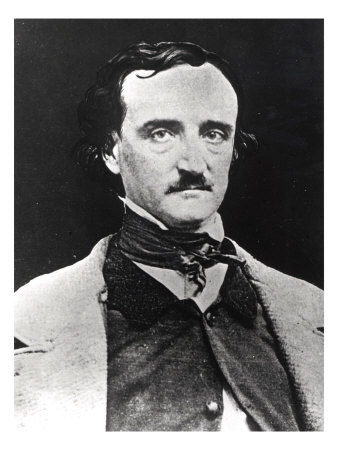February 2 サブライムと骨相学 (1) Phrenolgy and the Sublime (1) [擬似科学と文学]
February 02, 2009 (Sunday)
「擬似科学と文学」という幽霊の「マイカテゴリー」ができていて、気持ち悪いのでひとつきっかけづくりに書いてみる。
不親切な親切心で書くと、サブライムについて言及したのは「January 1-2 ゴシック小説と合理主義(その1)――擬似科学をめぐって(5) On Pseudosciences (5)」と「January 2-3 ゴシック小説と合理主義(その2)――擬似科学をめぐって(6) On Pseudosciences (6)」でした。不親切な記事だったと反省して親切に書くと、(5) で「倫理と審美を乖離させたエドマンド・バークのサブライムの美学が、イギリスで定式化されてゴシック小説の美学的バックボーンになったこと、その新しい美が何よりも恐怖を源泉としていたこと(「苦痛と危険の観念を刺激するにふさわしいものは何であれ、つまり、ともかく、恐ろしいもの、恐ろしい対象と関係するもの、ある点で恐怖に類するものは何であれ、ザ・サブライムの源泉である」)」と書きましたが、伝統的なギリシア以来の真 (the true) ・善 (the good) ・美 (the beautiful) の一致の美学(キリスト教ヨーロッパにおいては18世紀前半の新古典主義において再確認された、宗教的倫理が審美を支えるという信条)を転覆させて、「美」は倫理的でなくていいじゃんか、フカキョンのフレーズを借りれば「倫理や論理など~♪」(「Easy Rider」)という新たな美学の第一弾がザ・サブライムの美学として18世紀中葉にイギリスでエドマンド・バークによって主張されます(サブライム自体は前からある概念だし、大陸の方でも先行的に議論があったのだけれど、ザ・ビューティフルとの二項対立的定義づけを行ない、革新的・転覆的な美学を打ち出したのはバークだった)。そして上記引用のように「恐怖」 (terror/horror) を源泉におくザ・サブライムの美学は、バークのすぐのちにやはりイギリスで起こる、読者ならびに登場人物の恐怖を主眼とするゴシック文学の美学的バックボーンとなったのでした。つまり、たんに怖いだけじゃなくって、怖いのが美的な体験だと言い張れる強さをもっていたのでした。(もともとはザ・サブライムは宗教的な感情とも通じる「畏怖 awe」の念や、「魂の高揚 elevation of the soul」というような意味合いをもっていたのですけれど。)
さて、骨相学をアメリカに普及すべく1832年にやってきたシュプルツハイムがその年にボストンで客死したあと(このへん「January 7-8 でこちんと骨相学 (前篇)――擬似科学をめぐって(9) On Pseudosciences (9) [短期集中 擬似科学 Pseudoscience] 」参照)、ボストン骨相学協会の設立、ファウラー兄弟の活動があるわけですけれど、1830年代末にはイギリスからジョージ・クームがやってきて、講演旅行をおこない、アメリカの印象記もおさめた『1838、39、40年の骨相学的訪問の際の北米合衆国についての覚え書 Notes on the United States of North America, During a Phrenological Visit in 1838-9-40』という本を1841年に出版しています。
この、フィラデルフィアのCarey and Hart 社から出版された本の最初の序論には、「器官」の説明があり、「アイデアリティー ideality」(おおむね「想像力 imagination」を意味するとされています)と「サブリミティー sublimity」について、次のような記述になっています。――
19番と19aです。IDEALITY.―Uses: Love of the beautiful and splendid, desire of excellence, poeting feeling.―Abuses: Extravagance and absurd enthusiasm, preference of the showy and glaring to the solid and useful, a tendency to dwell in regions of fancy and to neglect the duties of life.
19. a. The organ of Sublimity: but not sufficiently ascertained. 〔サブリミティーの器官――しかしまだ十分に確認されていない〕
このあいだ広告を紹介したファウラーの『新・図説骨相学・生理学自己教則本 New Illustrated Self-Instructor in Phrenology and Physiology』〔「January 28 ファウラー&ウェルズ社の出版物リスト (2) ―1859年 Fowlers and Wells, 1859 Publications [擬似科学周辺]」〕では、器官の数も増えているのですが、21番とそのB に記述があります。
額の端に "ideality" の座があり、その奥に "sublimity" が位置づけられています。
書き込みはモーリちゃんの父の頭ではないですw。
本分の記述は次のようです(図版の下に、3枚目から4枚目にかけての "Sublimity" の記述を読みやすいように書き写します)――
シュプルツハイムの本では「まだ十分に確認されていない」 the sublime の器官が、ファウラーたちの本では詳しく解説されているのでした。
B. SUBILIMITY.
PERCEPTION and appreciation of the VAST, ILLIMITABLE, ENDLESS, OMNIPOTENT, and INIFINITE. Adapted to that infinitude which characterizes every department of nature. Perverted, it leads to bombast, and a wrong application of extravagant words and ideas.
VERY LARGE.―Have a literal passon for the wild, romantic, boundless, endless, infinite, eternal, and stupendous, and are like large, only more so.
LARGE.―Appreciate and admire the grand, sublime, vast, and magnificent in nature and art; admire and enjoy exceedingly mountain scenery, thunder, lightning, tempests, vast prospects, and all that is awful and magnificent, also the foaming, dashing cataract, a storm at sea, the lightning's vivid flash, and its accompanying thunder; the commotion of the elements, and the star-spangled canopy of heaven, and all manifestations of omnipotence and infinitude; with large Veneration, are particularly delighted by the inifinite as appertaining to the Deity, and His attributes and works; and with large Time added, have unspeakably grand conceptions of inifinitude as applicable to devotion, the past and future, and the character and worksof the Deity; with large intellectual organs, take a comprehensive view of subjects, and give illimitable scope to all mental investigations and conceptions, so that they will bear being carried out to any extent; and with Ideality large, add the beautiful and perfect to the sublime and inifinite.
FULL.―Enjoy granderu, sublimity, and infinitude quite well, and impart considerable of this element to thoughts, emotions, and expressions, and evince the same qualities as large, only in a less degree.
AVERAGE.―Possess considerableof this element,when it is powerfully excited, yet, under ordinary circumstances, manifest only an ordinary share of it.
MODERATE.―Are rather deficient in the conceptionand appreciation of the illimitable and infinite; and with Veneration moderate, fail to appreciate this element in nature and her Author.
SMALL.―Show a marked deficiency in this respect, and should earnestly cultivate it.
VERY SMALL.―Are almost destitute of sublime emotions and conceptions.
TO CULTIVATE.―Mount the lofty summit to contemplate the outstretched landscape; admire the grand and stupendous in towering mountain, rolling cloud, rushing wind and storm, loud thunder, majestic river, raging sea, rearing cataract, burning volcano, and the boundless, endless, infinite, and eternal in nature and her author. 291
TO RESTRAIN.―which is rarely ever necessary―refrain from the contemplation of the sublime: 292.
ファウラーたちによるこのような記述がいつごろから始まったのか、まだ調べておらんのですけれど、時期はともかく、モーリちゃんの父の推測では、これはたいへんアメリカ的な事態ではないかと思われ。そもそも自然のなかのサブライムな美をめでることがその造物主たる神 (her Author) をめでることにつながっているのは、反バーク的というか反動的なアメリカ的サブライムのありようです。
"Very Large" から "Very Small" というのはその器官の頭の「コブ」の大きさを言っていて、記述はおおむね程度の問題で、なにをこんなに長々と書くんじゃい、という気持ちもしなくもないですが、はしばしに上述の「自然」&「神」が出てきます。そして最後の2項目 "To Cultivate" と "To Restrain" は、それぞれ開拓と抑制の方法が書かれていて、「開拓」のほうでは、たとえば高い山に登ってはるかな風景を観照せよ、とか、湧き立つ雲や大きな雷鳴とか荒れる海とか、ようするに、自然と、自然の作者〔=神〕における無限・永遠なるものを称賛せよとという助言となっています。そして抑制の方は、「抑制は稀にしか必要となることはないが」という挿入節のあと、「ザ・サブライムなるものの観照を抑える」という至極あたりまえのことが書かれています。
もう少し文学的なところへつづく。たぶん。
January 27, February 18, 23 ポーの骨相学研究書評 On Pseudosciences (23) [擬似科学と文学]
January 27, 2009 (Tuesday)
February 18, 2009 (Wednesday)
February 23, 2009 (Sunday)
実は記念切手にかこつけてポーの肖像をばらまいてきたのは伏線で、骨相学的な問題を書こうとしたからなのでした。ポーは「でこちん」というほどでもないですけれど、その額は広く、骨相学的には、額の左右の、ファウラーの番号で言うと21番の "Ideality" 〔February 2 サブライムと骨相学 (1) Phrenolgy and the Sublime (1) など参照〕 ――ここって、19世紀も終わり近くなると "Beauty" になり、ただし簡便な説明としては "Taste, finish, elegance, poetry" ということになる〔「February 10 G・R・トンプソン編の『ポー選集』の「精神科学」 "Sciences of the Mind" in The Selected Writings of Edgar Allan Poe, edited by G. R. Thompson (2004) [擬似科学周辺]」に載せた1886年版の Life: Its Factors, Science, and Culture の第1巻 Mind, Organism, and Health by Higiene; Or Phrenology and Physiology Applied to Laws, Preservation, and Restoration of Health 掲載の骨相学チャートと解説参照〕――(うわっ、挿入が長いw)――の座が発達しているように、誰が見ても見えます。見えませんか。

image via 「オールポスターズのPortrait of Edgar Allan Poe ジクレープリント」 <https://www.allposters.co.jp/-sp/-Posters_i1734916_.htm> 〔これはダゲレオタイプ屋が撮ったもので Sarah Whitman が撮ったものではないです〕

image via "The Ghost of Edgar Allan Poe | Paranormalknowledge.com" <http://www.paranormalknowledge.com/articles/the-ghost-of-edgar-allan-poe.html> (Photo taken from brittanica.com)
ポーは1836年の3月号の『サザン・リテラリー・メッセンジャー(南部文芸通信)』誌にイギリス人女性のメアリ・L・マイルズという人が書いた骨相学の研究書(といってもどうやら20枚の図を入れて携帯の用にかなうようにした簡便なもののようなのですが)の書評を書いています(Review of Mrs. L. Miles - Phrenology and the Moral Influence of Phrenology <http://www.eapoe.org/works/criticsm/slm36m02.htm> )。冒頭ポーは「フレノロジーはもはや笑うべき対象ではない・・・・・・科学の威厳を身につけている」と書いています。「この科学の決定的に重要な諸点」が説明をわかりやすくするため(つまり「明快で、コンパクトで、携帯しやすい」ものにしたため)に犠牲にされている、ともポーは述べていて、このトーンは真剣です。あと、短篇小説「天邪鬼」で関心がうかがわれるように、ガル的というか、人間の「悪」の傾向を示す部分に興味をもっていることが "combativeness" の章への関心からわかります。
ポーは生前にどうやら自分の頭をみてもらったことがあるらしいことは、1841年10月27日付の友人F・W・トマス宛の手紙でわかります。―― ". . . Speaking of heads -- my own has been exhamined by several phrenologists -- all of whom spoke of me in a species of extravaganza which I should be ashamed to repeat" (["Poe to Thomas, October 27, 1841]," Ostrom, Letters, p. 185.) " (・・・・・・頭といえば――ぼく自身の頭を何人かの骨相学者に診てもらったことがあって――誰もがぼくのことを、ここで繰り返すのが恥ずかしいような狂想的なことばで語るんだ)。
WEB 上のどこかで読んだ、どこぞの人の文章によると(再発見したら注記します)、ポーの頭は典型的な詩人タイプの見本としてもてはやされることとなった、みたいなことですが、少なくともアメリカのファウラーの本(これはしばしば典型を具体的な人名を挙げて説明するわけです)にはポーへの言及は見つかりません。まあ、アメリカでは評価が低かったわけだし、それが事実とすれば、19世紀後半のヨーロッパでの話かもしれません。
もっと長く書こうと思っているうちに時間が経ってかえって思考がブツ切れになってしまうので、ブツ切れで( ..)φメモメモ的に出しておきます。 (2月23日雨の日曜日10時)
////////////////////////////
Review of Mrs. L. Miles - Phrenology and the Moral Influence of Phrenology <http://www.eapoe.org/works/criticsm/slm36m02.htm> E. A. Poe Society of Baltimore
"Poe and Phrenology" <http://www.eapoe.org/geninfo/poemisc.htm>〔上記アメリカのPoe Society の "A Few Minor Topics" のページ内の的確な解説と書誌〕
Mark Canada, "Flight into Fancy: Poe's Discovery of the Right Brain." The Southern Literary Journal, vol. 33, number 2 (Spring 2001): 62-79 <http://muse.jhu.edu/login?uri=/journals/southern_literary_journal/v033/33.2canada.html> 〔右脳がなんたらって擬似科学とされているだけでなく、既にポーについては20年以上前にコリン・ウィルソンが『ポルターガイスト』で指摘しているんすけど―― "Poe has written about it in a story called 'The Imp of the Perverse', in which he discusses the way in which we can feel a sudden urge to do something that horrifies us; the narrator of his story has succeeded in committing a 'perfect murder', and cannot resist a compulsion to go and shout about it in the street. ¶There is nothing very strange in this. It is simply the operation of what the psychiatrist Viktor Frankl calls 'the law of reverse effort'. The more a stutterer wants to stop stuttering, the worse he stutters. On the other hand, Frankl mentions a stutterer who was asked to play a stutterer in the school play, and was then unable to stutter. All this is explained by the recognition that 'you' live in the left half of the brain, and that another 'you' lives a few centimetres away in the other half. As soon as the left begins to interfere too much, it has the effect of 'throttling' the right, just as if a man had grabbed himself by the throat. We are all of us 'divided selves'." (Colin Wilson, Poltergeist!: A Study in Destructive Haunting [London: New English Library, 1981] pp. 48-49)〕



20Notes20on20the20United20States.jpg)
2C20Self-Instructor20in20Phrelonogy20and20Physiology.jpg)
2C20Self-Instructor20in20Phrenology2C20p.20iv-2ea84.jpg)
2C20Self-Instructor20in20Phrenology2C20p.20v-39d9d.jpg)
2C20Self-Instructor20in20Phrenology2C20p.20131-c7e68.jpg)
2C20Self-Instructor20in20Phrenology2C20p.20132-e43ec.jpg)
2C20Self-Instructor20in20Phrenology2C20p.20133-6e617.jpg)
2C20Self-Instructor20in20Phrenology2C20p.20134-294b0.jpg)
